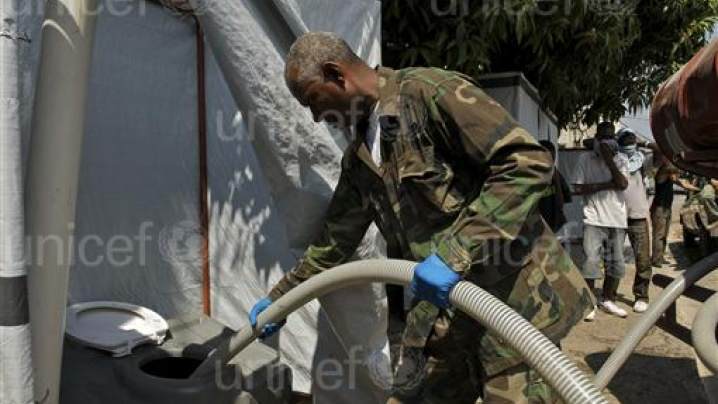Sanitation services refer to the management of excreta from the facilities used by individuals, through emptying and transport of excreta for treatment and eventual discharge or reuse.
The JMP ladder for sanitation
The JMP service ladders are used to benchmark and compare service levels across countries. These have been updated and expanded to facilitate enhanced global monitoring of drinking water, sanitation and hygiene. The new ladders build on the established improved/unimproved facility type classification, thereby providing continuity with past monitoring, and introduce new rungs with additional criteria relating to service levels.
Improved sanitation facilities are those designed to hygienically separate excreta from human contact. There are three main ways to meet the criteria for having a safely managed sanitation service (SDG 6.2). People should use improved sanitation facilities which are not shared with other households, and the excreta produced should either be:
- treated and disposed of in situ,
- stored temporarily and then emptied and treated off-site, or
- transported through a sewer with wastewater and then treated off-site.
If the excreta from improved sanitation facilities are not safely managed then people using those facilities are classed as having a basic sanitation service (SDG 1.4). People using improved facilities which are shared with other households are classified as having a limited service. The JMP also continues to monitor the population practising open defecation which is an explicit focus of SDG target 6.2. These services level classifications can also be visualized using excreta flow diagrams.
Sanitation ladder
-
Safely managed
Use of improved facilities that are not shared with other households and where excreta are safely disposed of in situ or removed and treated offsite
-
Basic
Use of improved facilities which are not shared with other households
-
Limited
Use of improved facilities shared between two or more households
-
Unimproved
Use of pit latrines without a slab or platform, hanging latrines or bucket latrines
-
Open defecation
Disposal of human faeces in fields, forests, bushes, open bodies of water, beaches and other open spaces or with solid waste
Note: Improved sanitation facilities are those designed to hygienically separate excreta from human contact, and include: flush/pour flush toilets connected to piped sewer systems, septic tanks or pit latrines; pit latrines with slabs (including ventilated pit latrines), and composting toilets
Monitoring SDG targets related to sanitation
The 2030 Agenda for Sustainable Development comprises 17 Sustainable Development Goals and 169 global targets. Goal 6 aims to ‘ensure availability and sustainable management of water and sanitation for all’ and includes targets for universal access to safe drinking water (6.1), sanitation and hygiene (6.2). WHO and UNICEF, through the JMP, are the custodian agencies responsible for global monitoring of progress on SDG targets related to WASH (see SDG Monitoring).

Enhancing data collection
Household surveys and censuses remain the primary source of information on the different types of facilities used by the population but information on safe management of excreta along the sanitation chain is also collected from administrative sources and regulators (see Data Sources).
The existing JMP core questions for household surveys have been widely used in national household surveys and censuses worldwide and have contributed to improvements in the quality and comparability of data collected over the past decade. The JMP has worked closely with international household survey programmes to develop new questions and indicators for enhanced monitoring of sanitation services and the sixth round of MICS surveys includes new questions on emptying and disposal of excreta from on-site sanitation facilities. .
While many countries have data on treatment of wastewater from households connected to sewers, relatively few have data on treatment of faecal sludge emptied from on-site systems such as septic tank and pit latrines. The JMP is supporting 6 countries (Bangladesh, Indonesia, Ecuador, Kenya, Serbia and Zambia) to pilot new methods and tools for routine monitoring of safe management of onsite sanitation (SMOSS) including containment, emptying, removal and treatment of faecal sludge.